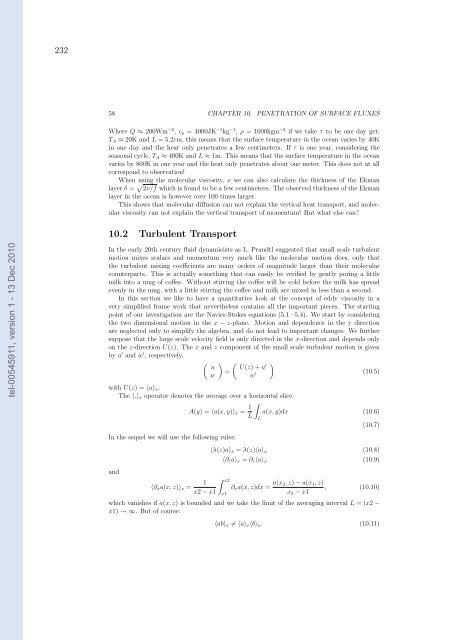Etudes et évaluation de processus océaniques par des hiérarchies ...
Etudes et évaluation de processus océaniques par des hiérarchies ...
Etudes et évaluation de processus océaniques par des hiérarchies ...
Create successful ePaper yourself
Turn your PDF publications into a flip-book with our unique Google optimized e-Paper software.
232<br />
58 CHAPTER 10. PENETRATION OF SURFACE FLUXES<br />
Where Q ≈ 200Wm −2 , c p = 4000JK −1 kg −1 , ρ = 1000kgm −3 if we take τ to be one day g<strong>et</strong>:<br />
T A ≈ 20K and L = 5.2cm, this means that the surface temperature in the ocean varies by 40K<br />
in one day and the heat only pen<strong>et</strong>rates a few centim<strong>et</strong>ers. If τ is one year, consi<strong>de</strong>ring the<br />
seasonal cycle, T A ≈ 400K and L ≈ 1m. This means that the surface temperature in the ocean<br />
varies by 800K in one year and the heat only pen<strong>et</strong>rates about one m<strong>et</strong>er. This does not at all<br />
correspond to observation!<br />
When using the molecular viscosity, ν we can also calculate the thickness of the Ekman<br />
layer δ = √ 2ν/f which is found to be a few centim<strong>et</strong>ers. The observed thickness of the Ekman<br />
layer in the ocean is however over 100 times larger.<br />
This shows that molecular diffusion can not explain the vertical heat transport, and molecular<br />
viscosity can not explain the vertical transport of momentum! But what else can?<br />
10.2 Turbulent Transport<br />
tel-00545911, version 1 - 13 Dec 2010<br />
In the early 20th century fluid dynamicists as L. Prandtl suggested that small scale turbulent<br />
motion mixes scalars and momentum very much like the molecular motion does, only that<br />
the turbulent mixing coefficients are many or<strong>de</strong>rs of magnitu<strong>de</strong> larger than their molecular<br />
counter<strong>par</strong>ts. This is actually som<strong>et</strong>hing that can easily be verified by gently poring a little<br />
milk into a mug of coffee. Without stirring the coffee will be cold before the milk has spread<br />
evenly in the mug, with a little stirring the coffee and milk are mixed in less than a second.<br />
In this section we like to have a quantitative look at the concept of eddy viscosity in a<br />
very simplified frame work that nevertheless contains all the important pieces. The starting<br />
point of our investigation are the Navier-Stokes equations (5.1 –5.4). We start by consi<strong>de</strong>ring<br />
the two dimensional motion in the x − z-plane. Motion and <strong>de</strong>pen<strong>de</strong>nce in the y direction<br />
are neglected only to simplify the algebra, and do not lead to important changes. We further<br />
suppose that the large scale velocity field is only directed in the x-direction and <strong>de</strong>pends only<br />
on the z-direction U(z). The x and z component of the small scale turbulent motion is given<br />
by u ′ and w ′ , respectively.<br />
( ) ( )<br />
u U(z) + u<br />
′<br />
=<br />
w w ′ (10.5)<br />
with U(z) = 〈u〉 x .<br />
The 〈.〉 x operator <strong>de</strong>notes the average over a horizontal slice:<br />
A(y) = 〈a(x,y)〉 x = 1 ∫<br />
a(x,y)dx (10.6)<br />
L L<br />
(10.7)<br />
In the sequel we will use the following rules:<br />
and<br />
〈∂ x a(x,z)〉 x =<br />
1<br />
x2 − x1<br />
〈λ(z)a〉 x = λ(z)〈a〉 x (10.8)<br />
〈∂ z a〉 x = ∂ z 〈a〉 x (10.9)<br />
∫ x2<br />
x1<br />
∂ x a(x,z)dx = a(x 2,z) − a(x 1 ,z)<br />
, (10.10)<br />
x 2 − x1<br />
which vanishes if a(x,z) is boun<strong>de</strong>d and we take the limit of the averaging interval L = (x2 −<br />
x1) → ∞. But of course:<br />
〈ab〉 x ≠ 〈a〉 x 〈b〉 x . (10.11)
















